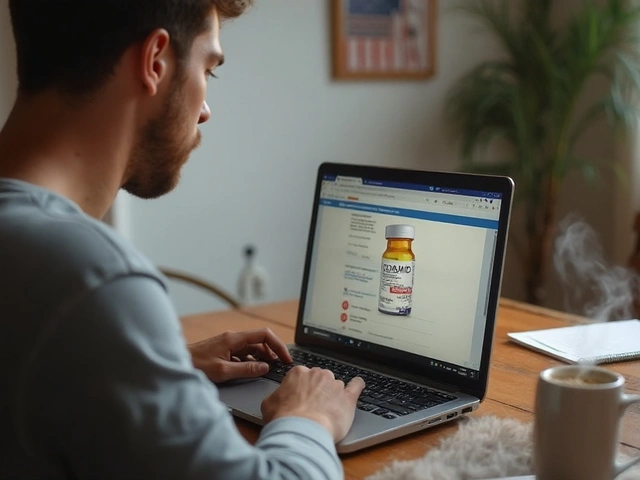Blood Pressure Medication Comparison Tool
Bystolic is often prescribed for high blood pressure, but many patients wonder if other drugs might work better for them. This guide lines up Bystolic against the most common alternatives, breaking down how each works, typical dosing, effectiveness, and side‑effect profiles. By the end you’ll know which option fits your health goals and lifestyle.
Quick Take
- Bystolic (nebivolol) combines beta‑blocking with nitric‑oxide‑mediated vessel relaxation.
- ACE inhibitors (e.g., Lisinopril) excel at blocking the renin‑angiotensin system.
- Calcium‑channel blockers (e.g., Amlodipine) are powerful vasodilators, especially for older adults.
- Traditional beta‑blockers (e.g., Metoprolol, Carvedilol) lower heart rate but lack nebivolol’s NO effect.
- Diuretics (e.g., Hydrochlorothiazide) reduce fluid volume and are cheap first‑line choices.
How Bystolic Works
When treating hypertension, Bystolic is a brand name for nebivolol, a third‑generation beta‑blocker that also releases nitric oxide to relax blood vessels. It blocks beta‑1 receptors, slowing the heart, while its nitric‑oxide activity widens arteries, giving a double‑action drop in systolic and diastolic pressure.
Typical dosing starts at 5mg once daily, with a usual maintenance range of 5-10mg. In clinical trials, Bystolic lowered systolic pressure by an average of 12mmHg and diastolic by 8mmHg, comparable to other beta‑blockers but with fewer reports of fatigue.
Key Alternatives at a Glance
Below are the most frequently prescribed antihypertensives that sit alongside Bystolic in treatment algorithms.
Lisinopril is an ACE inhibitor that blocks the conversion of angiotensin I to angiotensin II, reducing vasoconstriction. It’s often the first choice for patients with diabetes or kidney disease.
Amlodipine is a calcium‑channel blocker that prevents calcium from entering smooth‑muscle cells, causing arterial dilation. It works well for isolated systolic hypertension.
Metoprolol is a second‑generation beta‑blocker that primarily reduces heart rate and cardiac output. It’s popular after heart attacks.
Hydrochlorothiazide is a thiazide diuretic that promotes sodium and water excretion, lowering blood volume. It’s inexpensive and widely used in combination pills.
Losartan is an angiotensinII receptor blocker (ARB) that prevents angiotensinII from narrowing blood vessels. It’s a go‑to when ACE inhibitors cause cough.
Carvedilol is a non‑selective beta‑blocker with alpha‑blocking activity, offering both heart‑rate reduction and vasodilation. It’s often used in heart‑failure patients.
Atenolol is a beta‑1 selective blocker that is short‑acting and may require twice‑daily dosing. It’s less favored for hypertension alone because of limited vasodilatory effect.

Side‑Effect Profiles Compared
Understanding tolerability is key. Below is a side‑by‑side snapshot of the most common adverse events for each drug.
| Drug | Class | Typical Dose | Avg BP Reduction (mmHg) | Common Side Effects |
|---|---|---|---|---|
| Bystolic | Beta‑blocker (3rd gen) | 5‑10mg daily | 12/8 | Headache, mild dizziness, occasional bradycardia |
| Lisinopril | ACE inhibitor | 10‑40mg daily | 10/6 | Cough, hyperkalemia, angioedema (rare) |
| Amlodipine | Calcium‑channel blocker | 5‑10mg daily | 14/9 | Peripheral edema, flushing, gum hyperplasia |
| Metoprolol | Beta‑blocker (2nd gen) | 50‑200mg daily | 11/7 | Fatigue, cold extremities, sexual dysfunction |
| Hydrochlorothiazide | Thiazide diuretic | 12.5‑25mg daily | 9/5 | Increased urination, electrolyte imbalance, gout flare |
| Losartan | ARB | 50‑100mg daily | 10/6 | Dizziness, hyperkalemia, rare angioedema |
| Carvedilol | Beta‑blocker + alpha‑blocker | 6.25‑25mg twice daily | 13/8 | Weight gain, fatigue, orthostatic hypotension |
| Atenolol | Beta‑1 blocker | 25‑100mg daily | 9/5 | Bradycardia, sleep disturbances, cold hands/feet |
Choosing the Right Option for Your Situation
Not every drug suits every patient. Use the checklist below to match your health profile with a medication class.
- Kidney or diabetic concerns? Prefer ACE inhibitors (Lisinopril) or ARBs (Losartan) - they protect renal function.
- Older adult with isolated systolic hypertension? Amlodipine’s vasodilatory strength often outperforms beta‑blockers.
- History of asthma or COPD? Beta‑blockers may provoke bronchospasm; choose a calcium‑channel blocker or diuretic.
- Need heart‑rate control after a heart attack? Metoprolol or Carvedilol provide proven cardioprotective benefits.
- Concerned about fatigue? Bystolic’s nitric‑oxide edge reduces tiredness compared with older beta‑blockers.
- Cost sensitivity? Hydrochlorothiazide and generic ACE inhibitors are the cheapest options.
Practical Tips for Switching Medications
- Never stop Bystolic abruptly; taper over 1‑2 weeks to avoid rebound hypertension.
- If moving to an ACE inhibitor, check potassium levels and kidney function before start.
- When swapping to a calcium‑channel blocker, monitor for sudden swelling in ankles - it’s common but manageable.
- Combine a low‑dose diuretic with any other class for additive effect; adjust salt intake accordingly.
- Schedule follow‑up blood pressure checks 2‑4 weeks after any change to confirm target achievement.
Frequently Asked Questions
Can Bystolic be used as a first‑line drug for hypertension?
Yes, many guidelines list nebivolol as a viable first‑line option, especially for patients who would benefit from both heart‑rate control and vessel relaxation.
What makes nebivolol different from metoprolol?
Nebivolol adds nitric‑oxide‑mediated vasodilation, which generally leads to fewer fatigue complaints and a modest extra drop in blood pressure.
Are there any serious drug interactions with Bystolic?
Combine it cautiously with other heart‑rate‑lowering agents (e.g., digoxin) or strong CYP2D6 inhibitors, as they can amplify bradycardia.
How long does it take to see blood‑pressure improvement after starting Bystolic?
Most patients notice a measurable drop within one week, with full effect reached by 4‑6 weeks of consistent dosing.
Is Bystolic safe for pregnant women?
Beta‑blockers are generally avoided in pregnancy unless benefits outweigh risks; talk to a specialist before using nebivolol while pregnant.







Rashi Shetty
October 3, 2025 AT 21:19While the guide offers a comprehensive tabulation, it neglects the socioeconomic factors that influence drug selection. The emphasis on efficacy over cost overlooks the reality for many patients in developing regions. Moreover, the side‑effect discussion could benefit from quantitative incidence rates rather than vague descriptors 😊👍.
Queen Flipcharts
October 12, 2025 AT 17:31In the grand tapestry of a nation's health, hypertension remains a silent sentinel; addressing it with robust, domestically produced medications fortifies our collective resilience. One cannot ignore how pharmaceutical independence reflects true sovereignty, and thus the comparison must prioritize homegrown solutions.
Yojana Geete
October 21, 2025 AT 13:44oh my gosh i cant even lol this whole table feels like a drama series and i am here for the twists but also like why is nebivolol getting all the hype when amlodipine could be the real hero??
Jason Peart
October 30, 2025 AT 08:56I totally get why people are drawn to Bystolic's dual mechanism, but let’s break it down step by step.
First, the beta‑1 blockade gently calms the heart without the crushing fatigue that older beta‑blockers sometimes induce.
Second, the nitric‑oxide release adds a subtle vasodilation that many patients actually notice as a smoother blood pressure curve.
Third, the dosing is straightforward-just one pill a day, which boosts adherence, especially for those juggling complex med schedules.
Fourth, the side‑effect profile, while not nonexistent, tends toward mild headaches and occasional dizziness rather than the heavy foot‑cold fatigue of metoprolol.
Fifth, clinical trials have shown an average systolic drop of about twelve millimeters of mercury, which sits nicely between the aggressive diuretics and the modest ACE inhibitors.
Sixth, for patients with concurrent heart failure, nebivolol's heart‑rate control can be a lifesaver, provided we monitor for bradycardia.
Seventh, the cost factor is something we cannot ignore; generic nebivolol is pricier than many thiazides, but insurance formularies often cover it adequately.
Eighth, we must remember to taper off rather than stopping abruptly, to avoid rebound hypertension-a point the guide briefly mentions but deserves emphasis.
Ninth, when switching from an ACE inhibitor, keep an eye on potassium levels; the combination can tip the balance toward hyperkalemia.
Tenth, if a patient complains of persistent ankle swelling, consider adding a low‑dose diuretic rather than abandoning Bystolic altogether.
Eleventh, the drug interacts with strong CYP2D6 inhibitors, so a medication review is essential before prescribing.
Twelfth, for pregnant patients, we generally steer clear of beta‑blockers unless the benefits clearly outweigh the risks.
Thirteenth, lifestyle modifications-dietary sodium reduction, regular exercise-still amplify any pharmacologic gains, no matter the pill chosen.
Finally, the key takeaway is that Bystolic offers a balanced blend of heart‑rate control and vasodilation, making it a solid first‑line option for many, provided we tailor monitoring to each individual.
Jolanda Julyan
November 8, 2025 AT 05:09Indeed, the oversight you mention is glaring, and it underscores the need for a more holistic approach that doesn’t just cherry‑pick data points. By ignoring the economic constraints many patients face, the guide inadvertently privileges a privileged subset, which is unacceptable. A truly inclusive comparison would integrate cost‑effectiveness analyses, real‑world adherence statistics, and even regional availability, ensuring that clinicians everywhere can make informed choices without resorting to guesswork.
Kevin Huston
November 17, 2025 AT 01:21Cost beats efficacy any day.
Amanda Hamlet
November 25, 2025 AT 21:34While you sound passionate, it’s presumptuous to claim the guide is “unacceptable” without acknowledging the extensive research underpinning its efficacy data; perhaps a balanced critique would serve the community better.
Nolan Jones
December 4, 2025 AT 17:46For anyone considering a switch, remember that Bystolic’s half‑life is roughly 12 hours, so taking it at the same time each morning helps maintain steady plasma levels. Also, pairing it with a low‑dose thiazide can smooth out any residual spikes in systolic pressure.
Mithun Paul
December 13, 2025 AT 13:59The suggestion to combine with a thiazide is sound, yet one must vigilantly monitor electrolytes, especially potassium, to avoid hyperkalemia-a nuance often omitted in oversimplified guides.
Sandy Martin
December 22, 2025 AT 10:11I’ve seen patients transition from ACE inhibitors to Bystolic with minimal side effects, but it’s crucial they schedule a follow‑up within two weeks to ensure blood pressure goals are being met and no bradycardia develops.